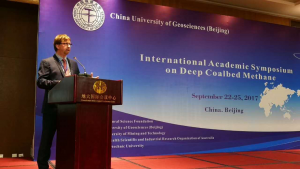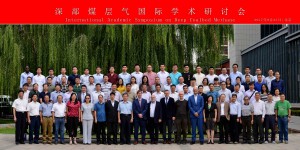I once visited a coal seam gas reservoir.
The year was 2008. The seam was 950 m below the surface. We accessed the reservoir thanks to the helpful personnel of a Chinese mine located just south of the city of Shenyang.
It was hot and none to confortable. But a great experience to see and really ‘feel’ the stresses that are exerted onto a coal seam at great depth.
The topic of deep coal beds and the implications of retrieving energy from them was the focus of a recent symposium held in Beijing at the China University of Geosciences. There were over 150 delegates from around China and several international participants. I was there as one of the keynote speakers*.
The symposium Chairperson and host organization was Prof Dazhen Tang from the China University of Geosciences. In addition, the other host organisations were: China University of Mining and Technology, Commonwealth Scientific and Industrial Research Organization (CSIRO) of Australia, Henan Polytechnic University and the National Natural Science Foundation of China. Delegates were from numerous Chinese universities as well as government and commercial organizations such as Sinopec, PetroChina, China United Coalbed Methane Company, China Geological Survey, CNOOC, CBM Center of North China Oil Field and many others.
Topics were varied and generated much discussion. It would be impossible to list all the subjects presented but they ranged from basic characteristics of deep coal reservoirs to the migration of gases from one reservoir to another. My own presentation concentrated, in part, on a hypothesis for the cause of the ‘boomerang’ trend of gas content (see, for example, Hamilton et al., 2012) in the Surat Basin of Australia and the implication of that for deep coal seams. With tongue firmly in cheek I’ve termed this the “Bart Simpson Blanket Hypothesis”. Watch this space for possible publication of these thoughts in a peer-reviewed journal.
Prof Tang, Prof Qin and two PhD graduate students, Shuling Tang and Yunguang Geng, are to be mentioned for their exceptional organizational and hosting skills – the whole symposium went extremely smoothly; in addition, the production of the proceedings volume plus another volume of papers focused on deep coalbed methane are to be highly commended. There is no doubt that this meeting has stimulated some excellent progress and likely has initiated new directions of research.
I look forward to the next symposium on deep coalbed methane.
*The other keynote speakers where: Prof. Yong Qin, China University of Mining and Technology, Xuzhou, China; Prof. Bernard Krooss (RWTH Aachen University, Germany); Prof Jack Pashin (Oklahoma State University, USA); Dr Zhejun Pan (CSIRO, Melbourne, Australia); Prof Andreas Busch (Heriot-Watt University, Edinburgh, UK); Prof. Sheik Rahman, University of New South Wales, Sydney, Australia; Prof Shimin Liu, The Pennsylvania State University, USA; Dr C. Özgen Karacan (US Geological Survey, Reston, Va., USA),
Hamilton, S.K., Esterle, J.S., Golding, S.D., 2012. Geological interpretation of gas content trends, Walloon Subgroup, eastern Surat Basin, Queensland, Australia. International Journal of Coal Geology 101, 21-35.





Comments are closed.